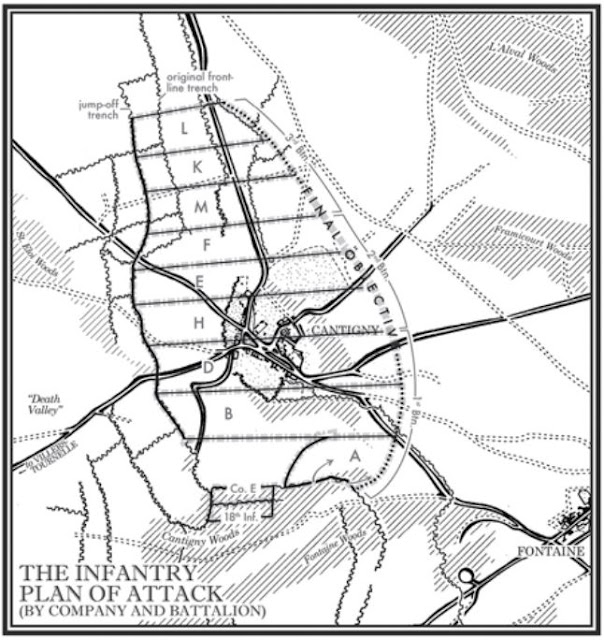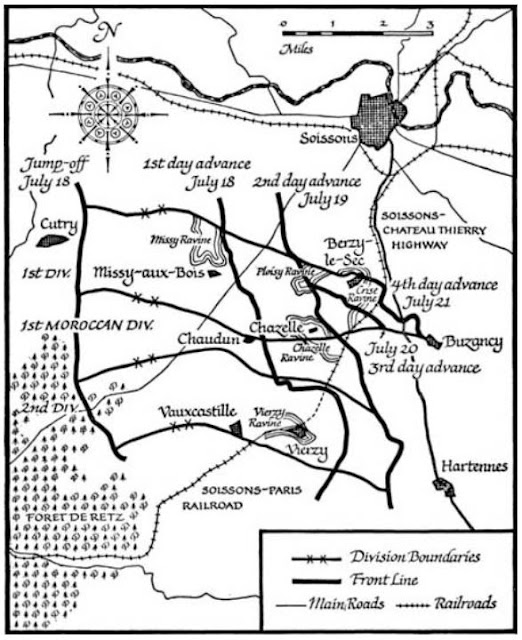With Memorial Day 2022 coming soon, I wish to share the story of William Duwe, a great-great uncle who died fighting in the First World War. My thanks go out to cousin Robert Knuth, who prompted my research on William, the "Black Lions" of the 28th Infantry Regiment, and the battles of Cantigny and Soissons.
William Duwe was born 10 May 1884, in Forestville, Door County, Wisconsin to parents William and Catherine (Tagge) Duwe. William's parents came to Door County from the Schleswig-Holstein region of Germany. The senior William Duwe served in the American Civil War (32nd Wisconsin Infantry Regiment), was postmaster of Forestville, a farmer and saloon-keeper. Both of William's parents died before he reached his eighth birthday. As a young man, William worked winters as a lumberjack in the forests of Michigan's Upper Peninsula and as a farm laborer in Forestville during the growing season.
In the patriotic fervor following United States entry into the First World War (6 April 1917), the all-volunteer Company F, 5th Regiment of the Wisconsin National Guard was formed in Sturgeon Bay, Wisconsin. One reason the company was formed was so that young men from the area could "stick together" and represent Door County as a unit. Company F left Sturgeon Bay on 17 August 1917 for National Guard training at Camp Douglas, Juneau County, Wisconsin. William Duwe volunteered for Company F despite being two years older than the maximum draft age of 31.
The Wisconsin and Michigan National Guards were federalized by the War Department, ordered to Camp MacArthur near Waco, Texas, and combined to form the 32nd ("Red Arrow") Division of the U.S. Army. In Texas, William and other men from Door County were assigned to the 128th Infantry Regiment, 32nd Infantry Division, and on 18 February 1918, they embarked at Hoboken, New Jersey, bound for Brest, France, disembarking there 6-7 March 1918.
Before the 32nd Infantry Division had arrived in France, General Headquarters decided it would supply replacement troops to depleted units. When this order was carried out, the 128th Infantry Regiment saw all of its privates, privates first class, and captains reassigned to the 1st Infantry Division (The "Big Red One"). William Duwe was assigned to Company L, 3rd Battalion, 28th Infantry Regiment, 2nd Infantry Brigade, 1st Infantry Division. 7,000 of the 32nd Infantry Division's 27,000 men were reassigned.
Transfer to the 1st Division, 28th Infantry Regiment was a fateful development for William Duwe, since it placed him in two actions that would prove to be milestones for the United States Army: the battles of Cantigny (28-30 May 1918) and of Soissons (18-22 July 1918).
Cantigny was the first offensive of the war commanded and executed by the American Expeditionary Force (AEF). The 28th Infantry led the attack on German-held Cantigny, beginning at 5:45 AM, 28 May 1918. It attacked across no-man's land with three battalions abreast after a punishing early-morning artillery barrage of the German positions. The artillery shelling pummeled the village of Cantigny and the trenches immediately to its west, but left troops in trenches to the north relatively untouched.
William's Company L, at the far left of the line of attack, suffered massive casualties when it advanced against these entrenched German troops, whose positions were masked by dust, smoke, and debris.
 |
Source: Davenport, Matthew J. First over there: the attack on Cantigny, America's first battle of World War I. New York : Thomas Dunne Books, St. Martin's Press, 2015, p. 108. |
Although German counter-attacks continued through the 29th, the Americans consolidated their hold by 30 May 1918. For its courageous action leading the attack in this battle, the 28th Infantry Regiment earned the nickname "The Black Lions of Cantigny."
The Battle of Soissons was part of a much larger Allied offensive intended to interrupt German railroad supply and communication lines. Allied success in this objective is viewed as a key turning point in the war, because German forces went on the defensive afterward and never regained the offensive during the remainder of the war.
 |
|
The preemptive German artillery fire wounded or killed several Company L men from Door County., According to Frank Parkman of Sturgeon Bay, who was interviewed for an article in the Door County Advocate, the same high explosive shell that wounded him wounded Ed Severson of Ellison Bay and George Culligan of Algoma, and also killed Harry Erickson of Sister Bay. Parkman said that William Duwe was hit in the small of the back with shrapnel and was weakened by a three mile walk in search of a medical aid station.
William
died of his wounds, probably at Base Hospital 7, near Tours,
Indre-et-Loire, France, on 23 July 1918. He was first buried in the
American section of St Symphorien Cemetery in Tours, Indre-et-Loire,
France. In 1920, William's remains were brought back to the United
States and reinterred in Arlington National Cemetery, near
Washington, D.C.
William's
grave is number 618, located in Section 18 of the cemetery. Information about William's grave site, including images of his headstone are viewable at the Arlington National Cemetery web site.
Sources:
Many sources were consulted to research the journeys taken by the men of Door County's volunteer "Company F" to the battlefields of France and Belgium. The Door County Library Newspaper Archive was especially valuable in documenting William's story.
Specific articles that mentioned William Duwe's service, wounding, and death included:
- "William Duwe Dead," Door County Advocate, 27 September 1918, p. 1, col. 3
- "Dies of His Wounds : William Duwe Succumbs to Wounds Received in Battle July 23rd : Was Member of Vol. Co. F," Door County News, 26 September 1918, p. 1, col. 1
- "Back from France: Frank Parkman, Company F Volunteer Returns Home Honorably Discharged," Door County Advocate, 17 January 1919, p. 1, col. 3
A good article on the history of Door County's volunteer Company F is:
- Jim Lundstrom, "War Comes to Door County: Remembering Hyper-patriotism and Anti-German Sentiments on 100th Anniversary of WWI," 14 November 2017, Door County Living, vol. 15(4), Winter 2017
A first-person account of Soissons was written as a student paper at the U.S. Army Infantry School by then-Captain, and later Commanding General of the 1st Infantry Division in the Second World War, Clarence Huebner:
Books consulted included:
- Coffman, Edward M. The war to end all wars: the American military experience in World War I. New York : Oxford University Press, 1998.
- Davenport, Matthew J. First over there: the attack on Cantigny, America's first battle of World War I. New York : Thomas Dunne Books, St. Martin's Press, 2015.
- Johnson, Douglas V. and Rolfe L. Hillman, Rolfe L. Soissons: 1918. College Station, TX: Texas A&M University Press, 1999.
.JPG)
No comments:
Post a Comment